Visit to a Russian ‘Ghost’ Village
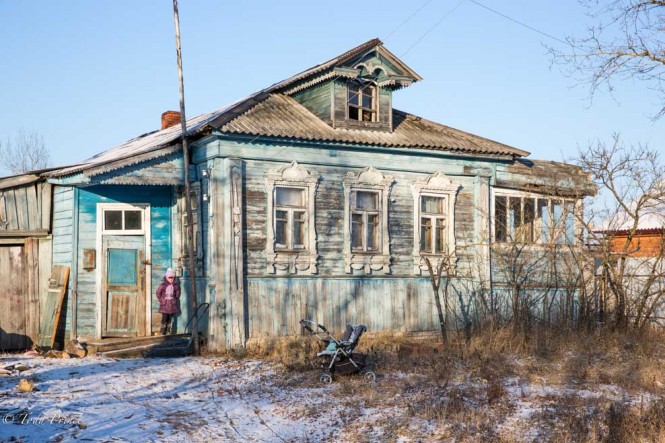
A home in the Vladimir Region village of Perovo, where I found a driver to show me the surrounding ‘ghost’ village cluster.
Russia continues today to experience an outflow of people from its villages to cities and towns, a process that is longer-term good for its economy and budget.
Yes, it has been happening for decades in Russia as well as in other countries, but media often report on the trend in Russia in negative terms.
Attention is normally focused on what is left behind – a village and its remaining elders – rather than on what is gained – the chance for a better life for those that leave, especially the young.
Maybe this is in part because the one part of the story – the ‘dying’ village – makes for striking visual content and a heart-wrenching story.
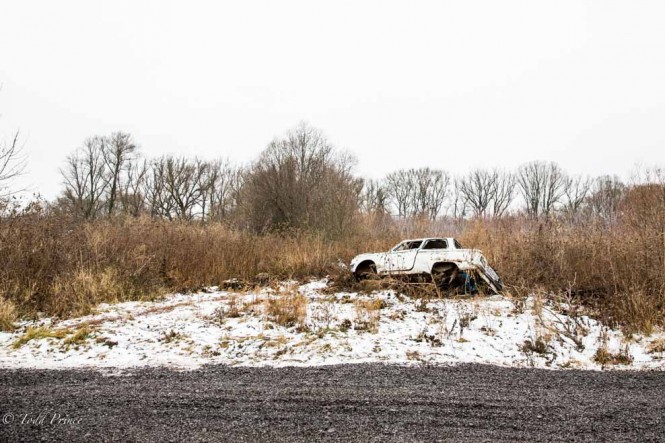
A photo from a Kursk village, which I wrote about in a previous blog post.
As I mentioned in a recent blog here, Russia has way too many villages….few of which can support themselves financially, and thus they can be seen as a drain on the budget.
These villages are scattered all over the 11 time zones of Russia, some in quite extreme places like the Far North and Siberia, which makes it harder to solve their many problems.
On the one hand, assistance needs to be extended. But upgrading some villages’ infrastructure may not encourage people to leave, which is probably the best solution for everyone in the long-run.
We are not talking about a village that me be a few kilometers from some town, as may be the case in Europe. We are talking about villages that may be 20 kilometers or more away from another village, which in turn is some 20 kilometers from a town.
I wanted to go spend one day in one of these so-called ‘ghost’ or ‘dying’ villages, which I sometimes see in the distance from train windows or during long car rides.
Below is my account of how I got there, whom I met and what I saw.
Proximity to Moscow
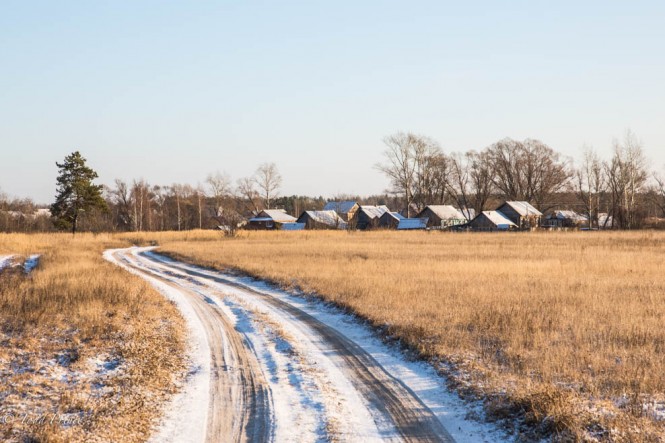
The road leading to the village of Perovo, where I found a driver to show me around the area.
To make my village visit manageable, I did a Google search for one in Vladimir region, which neighbors Moscow region.
The search turned up an article from 2009 about a village in Vladimir region that had such bad roads, food wasn’t being delivered and its people were complaining.
According to the article, village Mikhali was about 24 kilometers from Demidovo, the nearest ‘sizable’ village with a food store and pharmacy. Vladimir has 2,500 villages, about 270 of which are – like Mikhali – in the middle of nowhere.
I looked on Russian Railway’s website and found a train heading out of Kazinsky Train Station at around 8:10 am that would arrive at about 11:30 in a village that was 10 kilometers from Demidovo. It was not a direct ride. I had to change trains after 2.5 hours.
Help From Train Passengers
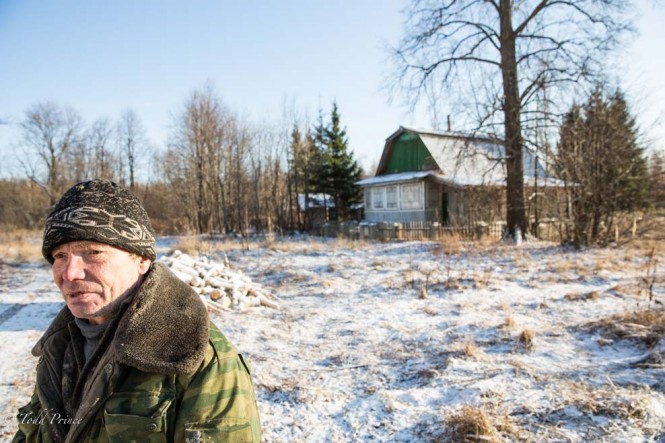
Nikolai lives in Perovo village and is helping with the restoration of a church in the neighboring village about 2 or 3 kilometers away.
While I occasionally stick out in crowds in Russia due to my non-slavic features, I felt more and more out of place as we approached the stop near Demidovo.
When I exited the train at my destination and headed east along the platform, one of the passengers – a middle-aged woman – came up to me. She knew I was not from here. She said ‘What are you looking for young man? Are you looking for Demidovo?’
I told her yes, that I wanted to go to Demidovo. She said I need to walk back to the end of the platform and then cross the tracks, walking straight up the alley to the main road. There will be taxis there she said, but recommended I hurry or they will all be gone.
I took my time walking along the platform. I took a few photos and then crossed the tracks. I must have arrived at the road where the taxis stand about 5 minutes after the train arrived. All the cabs were gone.
There was a village nearby and I walked over to see if I could find a driver. The village was basically a one-road town.
A few people had set up stands on the street to sell goods such as socks, gloves, dried fruit and cookies. The sellers arrived either in trucks or minivans, which they sat in to keep warm. It was about -2c.
Finding a Driver
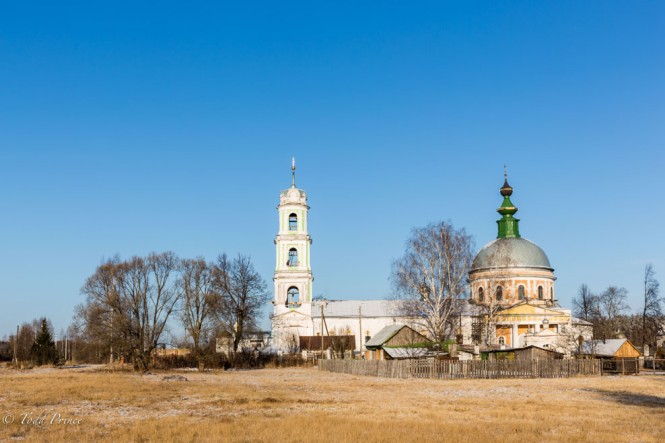
This village church in Perovo is in poor condition but operates. Nikolai and a colleague were working on the church’s upgrade.
I felt I was not dressed warm enough, so I bought handmade wool socks for 150 rubles ($3). They worked like magic and I felt a lot warmer. I walked over to an elder man standing next to a Lada and asked him if he was a driver.
He said no, and added that most of the cab drivers had gone to Demidovo. I would have to wait 20 min to 30 min for the cabs to return from Demidovo.
He said there was another pensioner who sometimes taxied and he could go see if he were home. Otherwise, he said, I could try to hitch a ride on the main road.
With my new socks on, I walked over to the main road to hitch. Cars passed by, but no one stopped. After about 20 minutes, a car pulled over. The driver was headed to Perovo, a village about halfway to Demidovo. I jumped in.
The driver asked where I was from and I told him America. He asked why the US was sticking its nose in Ukraine and said that Russia would never give in to US sanctions.
Russia, he said, has endured a lot over the years and can endure the US sanctions. He dropped me off, not taking a penny. He offered to get a friend to take me the rest of the way.
However, another car pulled up just then and that driver took me another 3km toward Demidovo, leaving me off next to a church in a village without taking a penny.
Escort to Perovo Village
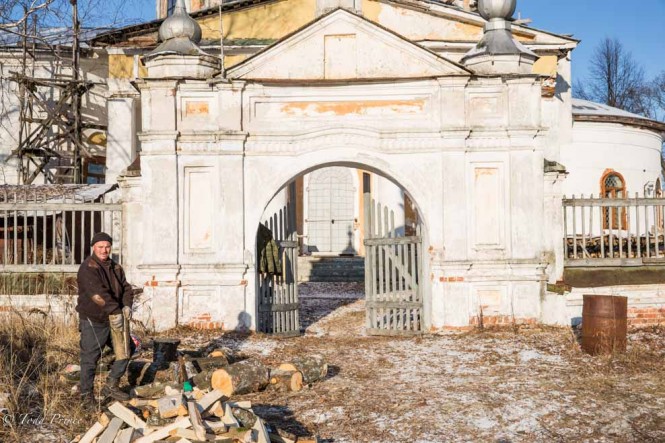
Nikolai’s colleague chopping wood for the church in the village neighboring Perovo.
After getting out of the car, I walked around the church, taking a few photos. The church was in very poor, but working condition. It served as the church not only for this village, but Perovo as well.
A huge, expensive home made of brick was being built across from the church. There were a few cars parked in front of that home, probably that of the workers.
Nikolai, who was cutting up wood for the church, came over to ask me what I was doing. I told him I had come from Moscow to take photos of some villages. I mentioned I wanted to go to Demidovo and to some of the outlying villages.
He said he knew a driver in Perovo who could take me around. He said that he and his colleague could walk me to the driver’s house – which was about 2km or 3km away – for 300 rubles ($6).
He explained that he had to charge that much because he would have to spend time walking back to the church from Perovo.
As we walked along the road to Perovo, Nikolai said that he was born in this area and then went to work in Siberia near Lake Baikal as a construction worker.
When his company stopped paying him in the early 1990s, he returned to his village. As I understood it, he helps out at the church and gets some pay.
I asked him if he knew who was building that big home across from the church and why. He had no idea, but thought it didn’t fit well into the surrounding atmosphere of modest wooden homes.
We then discuss Vladimir region and the potential for agriculture in the area. I then mentioned I had been to farm in Vladimir region that produced great cheese.
He looked distrustfully at me and said that he doesn’t like Russian cheese. The quality isn’t good, he said. Nikolai said he preferred foreign-made cheese.
Collective Farm Employment
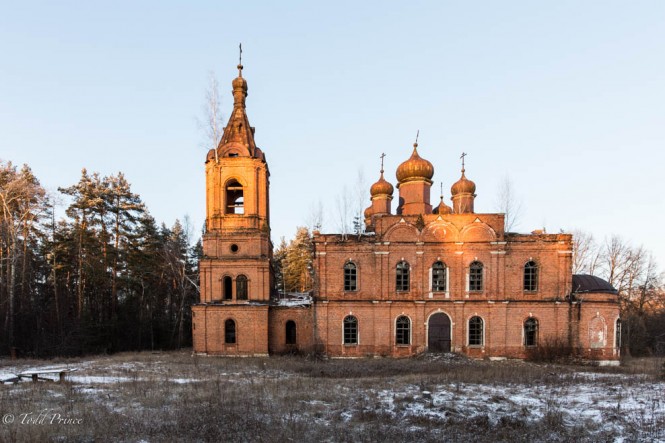
The setting sun throws the day’s last rays on this church in the village of Butilki.
While his colleague talked about the different trees along the road, Nikolai asked me if I had my documents – that is to say, my passport – with me.
He said I was the first American he has ever met. I sensed that he was having second thoughts about helping me. Nikolai said he wanted to be sure that I could show documents to the driver in case he asked.
I told him I had no problem showing them my documents and he could even write down the number of my passport if that made him feel less concerned. I also gave him my business card.
Perovo had a collective farm that used to employ a few hundred people as I understood from Nikolai and my driver, whom I will call Ivan. Now, it employed about 5 people.
There was otherwise no work in the village, which consisted of about two streets and maybe 40 homes. A fire in one home recently killed a father and his daughter, both of whom where pension age.
Some of the homes in Perovo were in poor condition, or simply abandoned, but quite a few, including that of my driver Ivan, looked quite good.
Like in thousands of other villages across Russia (especially those like Perovo close to Moscow), the young in Perovo are moving to Moscow or Moscow region to work, leaving behind older people.
It is easy to imagine that in 10 years, there will be fewer occupied homes here….Perovo may simply become a dacha village for the young that have moved to towns and cities.
Village Cluster Down to 5
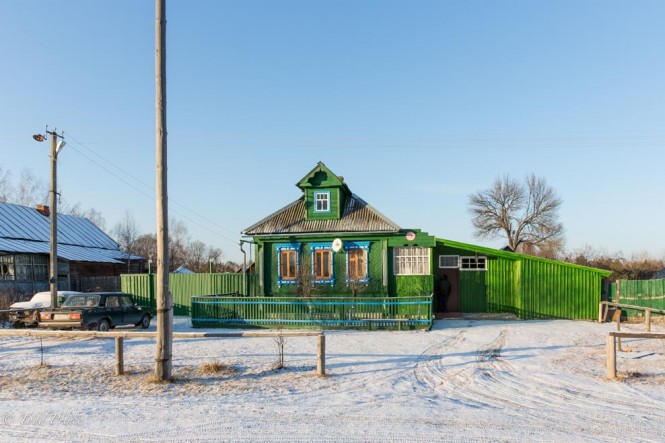
The well-kept home of a village driver in Perovo.
Nikolai went to the home of the driver Ivan and told him I need a driver. Ivan was a bit perplexed when I told him I wanted to see some villages like Mikhali. He asked if I was ‘allowed’ to do that.
I told him that I didn’t think there was anything wrong as I was just going to take pictures of villages for my website. There wasn’t anything strategic about the villages.
I then added that I was recently on a Russian state TV travel program, hoping that would put him at ease.
We first drove through some small villages that had a combination of beautifully maintained and collapsing homes before finally reaching Demidovo, the largest village in the area.
I don’t recall seeing anyone in the 3 or 4 villages we passed. When we reached Demidovo, there were people walking, some waiting for a bus and a car moving along the street.
Then we took a road that took us through a forest for about 10 kilometers or so to Mikali and the other villages. I recall only passing one moving car during the entire round trip ride.
Now I started to understand the context of the 2009 article about food delivery trucks not making it out to these villages.
Ivan, who was about 60 years old, mentioned that during Soviet times, Mikhali was part of a cluster of 17 villages around these forests. As far as he knew, only about five villages now were inhabited.
Only a couple of people lived in each one. As we passed one village, he pointed to it and said that a Muscovite was one of about two people living there. There were about 15 homes.
Abandoned Church
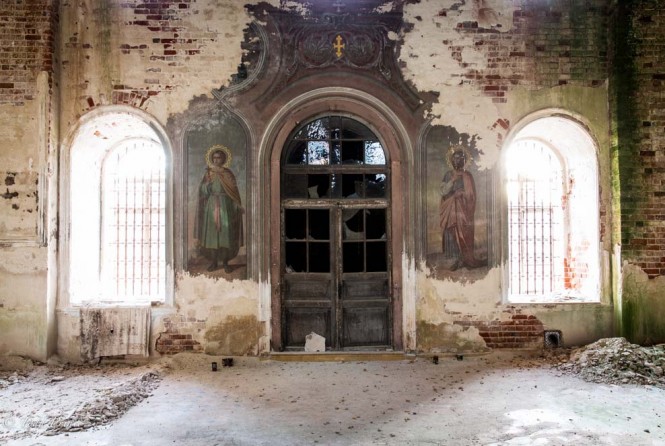
The inside an of an abandoned church in Bultiki in Vladimir region. Few of the paintings on the walls are visible.
Things though did not look as bad as the 2009 articles make it out to be. Maybe it was because it was a sunny day. Yes, some homes are abandoned and slowly collapsing, but others looked ok
It seems these villages have simply become dachas for owners and their adult children that have moved permanently to towns or cities.
They may come back to the villages only a few times a year to relax. I suspect the few people living in such villages maintain the appearance.
Finally, we passed Mikhail and headed a few more kilometers to Butilki, where there was an abandoned church. Perhaps two or three people lived full time in Butilki at best. At the end of the road, stood the abandoned, brick church.
One of the crosses on a cupola was bent, there was a tree growing from the roof. The inside was pretty much gutted. An alter had been made by visitors. A grave stood behind the church. Those visiting deceased relatives probably left flowers, ect.
Natural Outward Migration Process
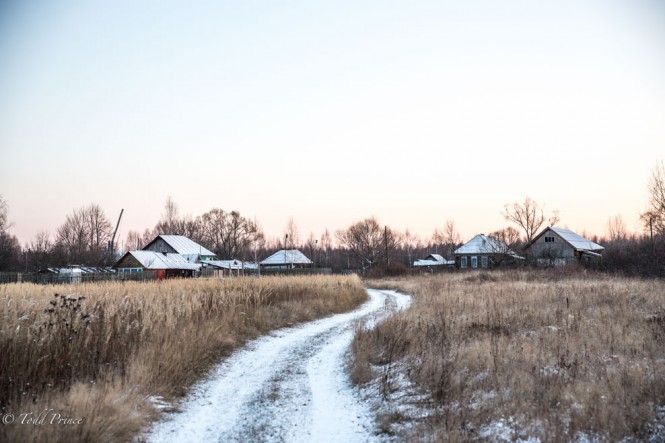
A snow covered dirt road leading to one of the largely empty villages 20km from Demidovo, the nearest large village.
As upsetting as it may seem, there is no reason to fight to maintain the church for the – and I am taking a guess here – 10 villagers or so that live permanently within a reasonable walking distance, taking into account that many of the villagers are elderly and can’t walk for kilometer on end.
After my village visit, I went to the town of Gus Khrustalni, which is about 40 kilometers away. The town is home to nearly 60,000 people.
The roads in that town seemed just as bad as when I was there 15 years ago. Historical buildings and factories were in poor condition. Little investment had been made in recent years.
I looked into the entrance of one factory I had visited in 2000. It looked no different and, in fact, it probably looks the same as 40 years ago, just darker and emptier.
The housing court yards had bumpy, dirt roads and I could imagine people trying to walk through the puddles and slush in spring and autumn. There was graffiti on building walls.
This town, and not the villages, made me depressed. This town looked like it was dying – something that could impact 60,000 people.
When regional authorities need to choose between say building a road for Mikhali’s few permanent residents or asphalting a courtyard in Gus Khrustalni serving a few hundred people, the decision is clear.
Please find the full gallery of photos from the Vladimir village here.
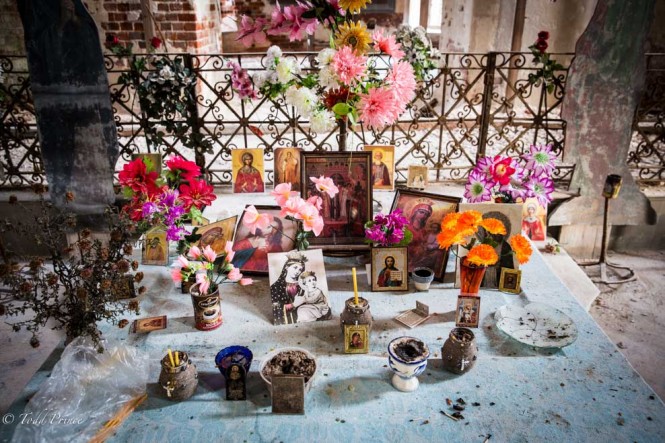
Russians still leave flowers and candles in this abandoned church.